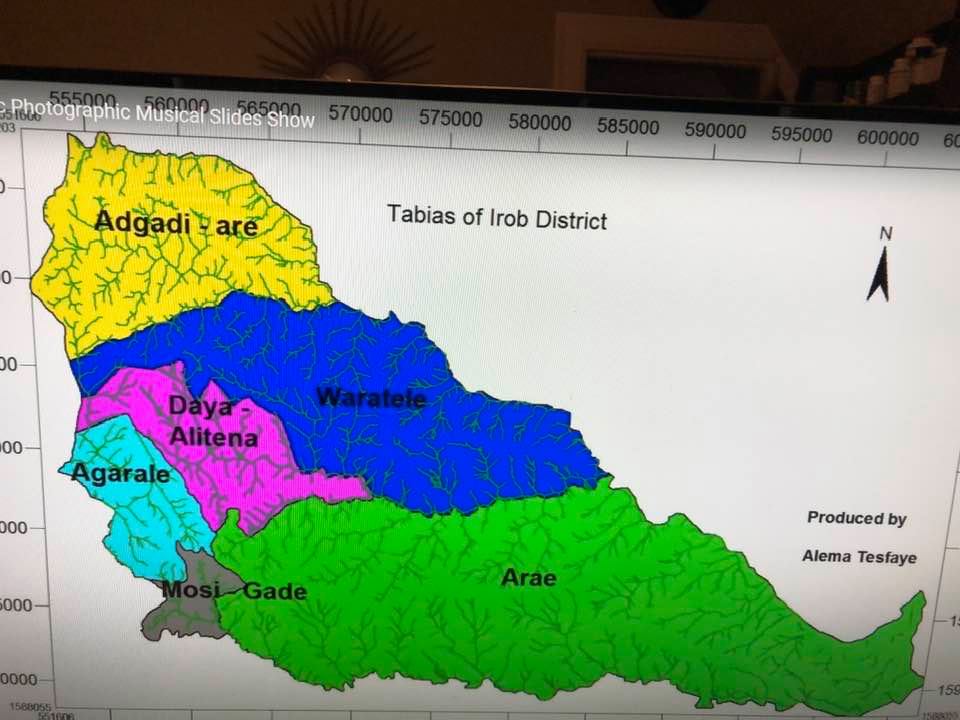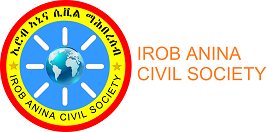
About Irob
Erob on the map is Irob.
Though the website will contain general information about Irob in many sections, we thought providing a brief introduction about Irob from the outset could be helpful. Irob is found in North-Eastern part of Tigray State. The name Irob represents both the ethnic identity of the people and the land they live in. The usual appellation of the Irob people and land is “adoo’ha Irob, The Three Irobs, because of three subdivisions of the people and the area they inhabit. The northern part is called Adgadi-Are, the central part Buknaiyti-Are and the Southern part is Hassaballa (Hassaballa-Are). The town of Alitena, the first host of modern education in Ethiopia, was traditional capital of Irob until two decades ago. The current government moved the Irob capital from Alitena to a place called Dawhan, about 6 Km south west of Alitena. Dawhan is located south side of the river that dissects the Irobland into two.

The Tigray State map.
As it is so common in all societies, Irobs do share culture and traditions with their adjacent neighbors. Hence both highland Tigrayan way of life and lowland Saho customs are manifested in the Irob culture. However, the Irobs also possess their own distinctive cultural features. How the Irob people celebrate Masqal/Mesqel holiday, for example is one of the well-known unique Irob ways. St. Michael’s days are celebrated twice a year, in November and June, in a special way as well. Most of Irobs are Christians, Orthodox and Catholic, and have many holidays in common. Masqal, Christmas and Easter are some of them.
One of the most famous monasteries, of Ethiopia, the Gundagunde Monastry, is found in the Irobland. The age old Lideta Lemariam Church of Alitena and the Saint Ghiorgis’ Church of Hido are in the Irobland as well. Interestingly three of them are in the three parts of Irob: Gundagunde in Hassaballa, Lideta-Lemariam in Buknayti-Are and Saint Ghiorghis in Adgadi-Are.
As indicated above, Irob due to its geographic location between the highland agriculturalists and the lowland mostly pastoralist communities, share many customs with both flanking societies. But the Irobs have their own traditional ways in actual practice of the customs. Marriage custom, for instance, is mostly the same with the highland Christians but Irobs, to some extent, have their own ways regarding marriage festivity. For example, the bridegroom’s side showy manifestation known as ‘Waradi’ is mainly Irob reality. The dowry practice in Irob differs from the habit of both neighbors as well.
Some of homestead tools and goods of the Irobs are the same with that of highlanders, especially goods made of terra cotta such as Gaana, Itro, Sarima, Mogogo but the Irobs make some of the utensils for serving drinks such as pitchers, flagons, carafes, beakers, mugs, cups etc. from horns and woods unlike the highlanders who make them mainly from terra cotta. The way the Irobs make goods made of grass and a kind such as milk containers: Faarena, Kurru, Daggude, Bahharre, Ayni, ‘Arare etc. differs from their highland neighbors but in this regard the Irob custom is similar to the customs of their lowland neighbors. There are also goods made of skin one can see in the Irob homes: Goobo/shield, Ghirib,‘Armo, Soro, Dabul, Ghirbo, Saar, Sibbadh,‘Okkat, ‘Hil’hilo, Ma’hzal, Sido, Kiba (Gurade-are), etc.
Tools the Irobs make out of wood include: Dawdena, Galadda, Wayda, Lakle-galadda, Madagdag, Moogod, Moogod-na, Koorayto, Lifeena, Masbana, Diga, Ilo, Sefseffo, Ttela, ‘Haklo, Naa, Ed’erto, Dukka, Member, ‘Arat, Qero etc. Materials for traditional plow: Nayiit, Ar’ut, ‘Erfe, Dugre, Qaraqiro, Qetirti, etc. are made of wood as well. These tools are made by their highland neighbors as well. Types of sports and games the Irob play include: Latitiya, Qarsa, Dufla, Arda, Gabatha, Fatana dha, fiddho, Wuuno etc.
It is the Irob tradition to relate genealogy to their progenies. Irobs also pass on their folklores and traditions in their traditional ways known as Tine-yan-tine, Simbo-simbot etc. The fairytales and orally told fictions too are conveyed this way; these are some of the Irob traditional facts.
Something that must not be forgotten when we talk about Irob culture is ‘Adar. ‘Adars are poems recited to convey one’s feelings of happiness or sadness. Some other concerns and views are expressed by way of ‘Adars as well. Irob is also very well-known by its cultural icons like Ghi’dim and Sola. Burkuta can be mentioned as one of the common cultures of Irob as well.
Other important custom that made Irob historically unique, especially compared to the highland society, was relative democratic norms. The Irobs had their own electoral system with which they elected their leaders. The leaders used to elect the top leader known as Ona among themselves. The Irobs also had a democratic familial relationship, and other democratic norms. But those norms and traditions have been suppressed by consecutive antidemocratic regional and national governments.
Today’s Irob, especially after the 1998 Eritrean Occupation, is different. The Irob people endured many natural and manmade hardships. Especially following the 1998 invasion and occupation of Irob territory by Eritrea, many clues indicate that, Irob in fact might be heading towards collapse. The two years of occupation, the war and its aftermath destroyed the socio-economic fabric of Irob community. Subsequently Irob became almost unrecognizable. The forest and all big trees that we once knew are not there. The two years stay of the Eritrean occupying force in Irob-land caused massive destruction of the environment and contributed to desertification of the area. Animal rearing which was part of Irob livelihood in the occupied area is unthinkable now. The social, environmental and infrastructural destruction is immense. Irob is still suffering from this destruction after two decades.

